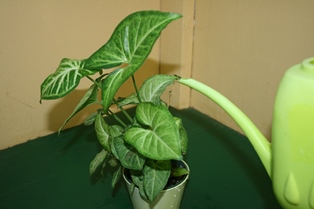How to Water Houseplants: You Can Grow That!
At first glance, watering might seem like the indoor gardener’s easiest chore, but it’s actually the most challenging. Knowing when and how to water is a skill that leads to healthy, vigorous houseplants.
The number one rule of watering indoor plants is to water on demand. Don’t water your houseplants on a set schedule. Give your plants a drink only when they need it. When to water varies according to a variety of factors.
Type of plant
Get to know each of your plants and their water needs. Although many houseplants like to dry out some before they require water, some, like African violets and citrus, prefer to be kept moist. Cactus and succulents need to go nearly dry before getting a drink. Some plants forgive you when you forget to water them and perk up despite droopy leaves, like peace lily. Other plants, like maidenhair fern, never recover from underwatering. Large-leaved plants tend to require more water than small-leaved ones, and thick, waxy leaves withstand dry conditions the best of all.


Time of year
Houseplants tend to dry out more often during spring and summer months. Indoor gardens usually require less water in fall and winter, but forced air heating can dry out soil. Hanging and elevated plants also dry out more quickly than their floor-level counterparts. Some plants go dormant in winter and should not be watered at all.
Light, temperature and humidity levels
Plants in bright locations require water more frequently than those in dim light. Dry air causes plants to need water more often than those grown in humid conditions. The higher the temperature, the more leaves will transpire (their form of perspiring), which causes plants to need a drink.
Houseplant soil type
Heavy soils with a lot of peat moss and compost hold in moisture longer than light soils containing perlite or sand. Determine the weight of your soil by picking up a small amount after you’ve watered and squeeze. If the soil stays balled, it’s heavy and will need less frequent watering than a light soil that easily crumbles.
Indoor plant container types
Terra-cotta pots are porous and dry out much more quickly than plastic and glazed ceramic pots.
Determine houseplant water readiness
Before you water, it’s important to make sure a plant needs it. You can do this by inserting your finger to the first knuckle. Water only if it feels dry below the surface. For larger plants, stick a wooden skewer in the soil and remove. If it comes out clean, it’s time to water, but if soil is stuck to the skewer, don’t irrigate. For small pots, use the pickup test. The plant will feel lightweight if the soil is dry.
How to water indoor plants
Always water with tepid to warm water-never cold. Studies show that cold water causes leaf spotting and can shock plants. Most plants like to be watered from above. If possible, take the plant to the sink and run water through until the soil is soaked and the pot feels heavy. Water large plants on location, but make sure that the bottom of the pot isn’t sitting in water when you’re done. Use a turkey baster, sponge or rag to remove any excess.
Some plants do better when watered from below, such as African violets. To bottom water, set the plant pot in a slightly larger container filled with water. Let the plant soak until the soil is well saturated.
For more tips on watering houseplants, watch our video on topic below.





